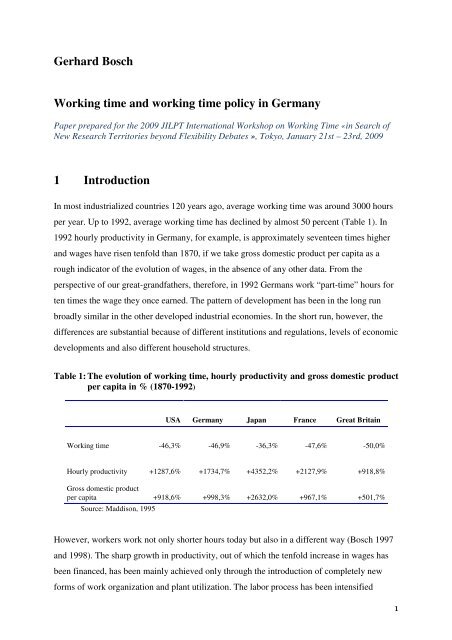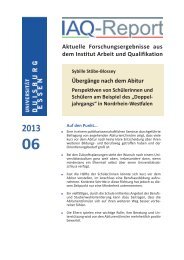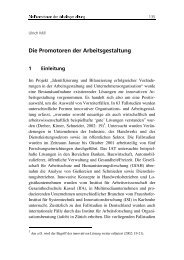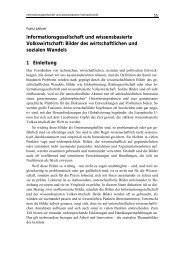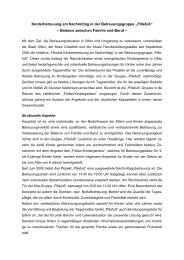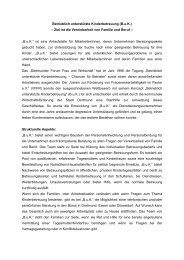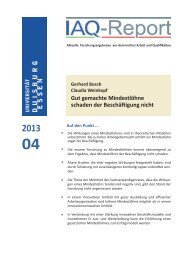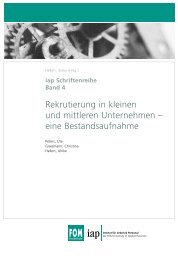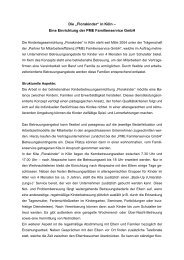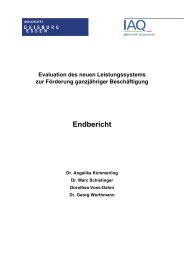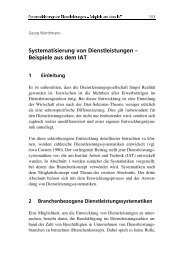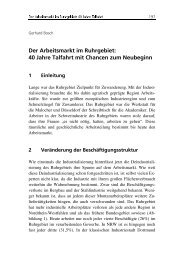Gerhard Bosch Working time and working time policy in Germany 1 ...
Gerhard Bosch Working time and working time policy in Germany 1 ...
Gerhard Bosch Working time and working time policy in Germany 1 ...
You also want an ePaper? Increase the reach of your titles
YUMPU automatically turns print PDFs into web optimized ePapers that Google loves.
<strong>Gerhard</strong> <strong>Bosch</strong><br />
<strong>Work<strong>in</strong>g</strong> <strong>time</strong> <strong>and</strong> <strong>work<strong>in</strong>g</strong> <strong>time</strong> <strong>policy</strong> <strong>in</strong> <strong>Germany</strong><br />
Paper prepared for the 2009 JILPT International Workshop on <strong>Work<strong>in</strong>g</strong> Time «<strong>in</strong> Search of<br />
New Research Territories beyond Flexibility Debates », Tokyo, January 21st – 23rd, 2009<br />
1 Introduction<br />
In most <strong>in</strong>dustrialized countries 120 years ago, average <strong>work<strong>in</strong>g</strong> <strong>time</strong> was around 3000 hours<br />
per year. Up to 1992, average <strong>work<strong>in</strong>g</strong> <strong>time</strong> has decl<strong>in</strong>ed by almost 50 percent (Table 1). In<br />
1992 hourly productivity <strong>in</strong> <strong>Germany</strong>, for example, is approximately seventeen <strong>time</strong>s higher<br />
<strong>and</strong> wages have risen tenfold than 1870, if we take gross domestic product per capita as a<br />
rough <strong>in</strong>dicator of the evolution of wages, <strong>in</strong> the absence of any other data. From the<br />
perspective of our great-gr<strong>and</strong>fathers, therefore, <strong>in</strong> 1992 Germans work “part-<strong>time</strong>” hours for<br />
ten <strong>time</strong>s the wage they once earned. The pattern of development has been <strong>in</strong> the long run<br />
broadly similar <strong>in</strong> the other developed <strong>in</strong>dustrial economies. In the short run, however, the<br />
differences are substantial because of different <strong>in</strong>stitutions <strong>and</strong> regulations, levels of economic<br />
developments <strong>and</strong> also different household structures.<br />
Table 1: The evolution of <strong>work<strong>in</strong>g</strong> <strong>time</strong>, hourly productivity <strong>and</strong> gross domestic product<br />
per capita <strong>in</strong> % (1870-1992)<br />
<strong>Work<strong>in</strong>g</strong> <strong>time</strong><br />
Hourly productivity<br />
Gross domestic product<br />
per capita<br />
Source: Maddison, 1995<br />
USA<br />
-46,3%<br />
+1287,6%<br />
+918,6%<br />
<strong>Germany</strong><br />
-46,9%<br />
+1734,7%<br />
+998,3%<br />
Japan<br />
-36,3%<br />
+4352,2%<br />
+2632,0%<br />
France<br />
-47,6%<br />
+2127,9%<br />
+967,1%<br />
Great Brita<strong>in</strong><br />
-50,0%<br />
+918,8%<br />
+501,7%<br />
However, workers work not only shorter hours today but also <strong>in</strong> a different way (<strong>Bosch</strong> 1997<br />
<strong>and</strong> 1998). The sharp growth <strong>in</strong> productivity, out of which the tenfold <strong>in</strong>crease <strong>in</strong> wages has<br />
been f<strong>in</strong>anced, has been ma<strong>in</strong>ly achieved only through the <strong>in</strong>troduction of completely new<br />
forms of work organization <strong>and</strong> plant utilization. The labor process has been <strong>in</strong>tensified<br />
1
through scientific management methods, such as Taylorism. Mach<strong>in</strong>e utilization <strong>time</strong>s have<br />
been extended by reduc<strong>in</strong>g stoppage <strong>time</strong>s <strong>and</strong> <strong>in</strong>creas<strong>in</strong>g operat<strong>in</strong>g hours (Anxo et. al. 1995;<br />
Foss 1984). Shorter average <strong>work<strong>in</strong>g</strong> <strong>time</strong>s per worker have not proved to be an obstacle to<br />
<strong>in</strong>creased capital stock utilization. Different forms of shift organization have been developed.<br />
In cont<strong>in</strong>uous (i.e. 7-day) production plants, such as <strong>in</strong> the steel, textiles <strong>and</strong> chemical<br />
<strong>in</strong>dustries, two-shift systems were the norm <strong>in</strong> the last century. At the beg<strong>in</strong>n<strong>in</strong>g of this<br />
century, there was a change to three, after the Second World War to four <strong>and</strong> <strong>in</strong> recent years<br />
to five-shift systems.<br />
In the early years of <strong>in</strong>dustrial development the man did not earn a family wage. In<br />
consequence women <strong>and</strong> even children had to work. The <strong>in</strong>crease of hourly wages of the last<br />
century made it possible for households to reduce their labour supply <strong>and</strong> the bread-w<strong>in</strong>ner<br />
model with the women stay<strong>in</strong>g at home became the dom<strong>in</strong>ant model for comb<strong>in</strong><strong>in</strong>g work <strong>and</strong><br />
family life. This has changed <strong>in</strong> the last decades. Because of many reasons (better education,<br />
chang<strong>in</strong>g preferences, decl<strong>in</strong>e of real wages) <strong>in</strong> most <strong>in</strong>dustrialized countries more <strong>and</strong> more<br />
women are <strong>work<strong>in</strong>g</strong>. Their <strong>work<strong>in</strong>g</strong> hours depend very much on <strong>in</strong>stitutions of the welfare<br />
state like provision of child care, school hours, public care provision, tax <strong>and</strong> social security<br />
systems). S<strong>in</strong>ce these <strong>in</strong>stitutions differ substantially hours of women differ more than hours<br />
of man between countries.<br />
In the follow<strong>in</strong>g I would like to describe the recent developments of <strong>work<strong>in</strong>g</strong> hours <strong>in</strong><br />
<strong>Germany</strong>. Section 2 of this paper provides a description of regulations of <strong>work<strong>in</strong>g</strong> hours.<br />
Section 3 surveys the usual weekly <strong>and</strong> yearly <strong>work<strong>in</strong>g</strong> hours <strong>in</strong> <strong>Germany</strong> also <strong>in</strong> comparison<br />
with other European countries. In section 4 I analyse the impact of the German conservative<br />
welfare state on <strong>work<strong>in</strong>g</strong> hours of men <strong>and</strong> women. Section 5 analyzes the decoupl<strong>in</strong>g of<br />
operat<strong>in</strong>g <strong>and</strong> <strong>work<strong>in</strong>g</strong> hours. Section 6 looks on the present discussion on work shar<strong>in</strong>g after<br />
to mitigate the negative employment effects of the f<strong>in</strong>ancial crisis. Section 7 summarizes the<br />
results from these empirical f<strong>in</strong>d<strong>in</strong>gs.<br />
2
2 Regulation of <strong>work<strong>in</strong>g</strong> <strong>time</strong><br />
The German <strong>work<strong>in</strong>g</strong> <strong>time</strong> law (last revision <strong>in</strong> 2006) covers all employees with the exception<br />
of managerial staff. The law stipulates that daily <strong>work<strong>in</strong>g</strong> hours should not exceed 8 hours.<br />
The <strong>work<strong>in</strong>g</strong> day, however, can be extended to 10 hours if with<strong>in</strong> six month the average of 8<br />
hours is not exceeded. Deviations are possible by collective agreements, firms agreements or<br />
by approval through authorities. S<strong>in</strong>ce Saturday is a <strong>work<strong>in</strong>g</strong> day the maximum weekly<br />
<strong>work<strong>in</strong>g</strong> hours are 60 hours. Wages for Public Holidays are paid if they fall on a <strong>work<strong>in</strong>g</strong> day.<br />
Work on Sunday <strong>and</strong> Public Holidays is prohibited. Exceptions have to be approved by<br />
authorities. Possible reasons for exceptions are technical reasons like the need for cont<strong>in</strong>uous<br />
production, economic reasons to safeguard or create jobs, social reasons like car<strong>in</strong>g for people<br />
or public <strong>in</strong>terest like security. For daily <strong>work<strong>in</strong>g</strong> hours between between 6 <strong>and</strong> 9 hours there<br />
is a m<strong>in</strong>imum unpaid rest of 30 m<strong>in</strong>utes, for longer <strong>work<strong>in</strong>g</strong> hours it is 45 M<strong>in</strong>utes. The<br />
m<strong>in</strong>imum rest <strong>time</strong> between 2 shifts is 11 hours. There are 20 <strong>work<strong>in</strong>g</strong> days paid vacation.<br />
Part-<strong>time</strong> workers have to be paid the same hourly rates as full-<strong>time</strong>rs. Part-<strong>time</strong>rs receive<br />
social benefits pro rata.<br />
The German <strong>work<strong>in</strong>g</strong> <strong>time</strong> law had to be changed due to European directives. Because of the<br />
European <strong>Work<strong>in</strong>g</strong> Time Directive (1993) 1 paid vacations were <strong>in</strong>creased from 3 to 4 weeks<br />
<strong>and</strong> due to the European Directive on Part-Time-Work (1997) 2 equal treatment of part-<strong>time</strong>rs<br />
was implemented.<br />
The duration <strong>and</strong> distribution of <strong>work<strong>in</strong>g</strong> hours is ma<strong>in</strong>ly regulated by collective agreements.<br />
Average weekly <strong>work<strong>in</strong>g</strong> hours were reduced to 40 hours <strong>in</strong> nearly all <strong>in</strong>dustries. Paid<br />
vacation were raised to 30 days for most workers. After the long strike on <strong>work<strong>in</strong>g</strong> <strong>time</strong><br />
reductions weekly <strong>work<strong>in</strong>g</strong> hours were reduced <strong>in</strong> several steps until 1995 to 35 hours a week<br />
<strong>in</strong> the German engeneer<strong>in</strong>g <strong>in</strong>dustry. Unions of other <strong>in</strong>dustries tried to follow this example<br />
but <strong>in</strong> most <strong>in</strong>dustries did not succeed to reduce <strong>work<strong>in</strong>g</strong> hours to the low level of the<br />
engeer<strong>in</strong>g <strong>in</strong>dustry. S<strong>in</strong>ce 1995 collectively agreed <strong>work<strong>in</strong>g</strong> hours are stagnat<strong>in</strong>g <strong>in</strong> West<br />
<strong>Germany</strong>. In some <strong>in</strong>dustries the unions even had to accept <strong>work<strong>in</strong>g</strong> <strong>time</strong> <strong>in</strong>creases (like <strong>in</strong><br />
public service from 38,5 to 39 hours). Only <strong>in</strong> East <strong>Germany</strong> slight adjustment to the lower<br />
Wets German level was agreed upon (Table 2). Today the agreed <strong>work<strong>in</strong>g</strong> hours for full-<strong>time</strong><br />
workers are aroung 1659 a year <strong>in</strong> West <strong>and</strong> around 1720 hours <strong>in</strong> East <strong>Germany</strong>. There are<br />
1 http://eur-lex.europa.eu/LexUriServ/LexUriServ.do?uri=CELEX:32003L0088:EN:NOT<br />
2 http://eur-lex.europa.eu/LexUriServ/LexUriServ.do?uri=CELEX:31997L0081:EN:NOT<br />
3
substantial differences by <strong>in</strong>dustries. Agreed weekly <strong>work<strong>in</strong>g</strong> hours vary from 35 <strong>in</strong> the<br />
enger<strong>in</strong>g <strong>in</strong>dustry to 37,5 <strong>in</strong> the chemiccal <strong>in</strong>dustry (West), to 38 <strong>in</strong> <strong>in</strong>surances <strong>and</strong> 39 <strong>in</strong><br />
banks (East <strong>and</strong> West) up to 40 hours <strong>in</strong> construction (East <strong>and</strong> West) <strong>and</strong> 40 hours <strong>in</strong> Hotels<br />
<strong>and</strong> restaurants (East).<br />
Table 2: Collectively agreed weekly <strong>and</strong> yearly <strong>work<strong>in</strong>g</strong> <strong>time</strong> 1990 to 2006<br />
(<strong>in</strong> hours)<br />
Weekly <strong>work<strong>in</strong>g</strong> <strong>time</strong> Yearly <strong>work<strong>in</strong>g</strong> <strong>time</strong><br />
year West East West East<br />
1990 38,4 1.689,1<br />
1991 38,1 40,2 1.676,0<br />
1992 38,1 40,1 1.672,9<br />
1993 37,7 40,0 1.659,8<br />
1994 37,7 39,7 1.655,9<br />
1995 37,5 39,5 1.651,9<br />
1996 37,5 39,4 1.645,1<br />
1997 37,5 39,4 1.644,4<br />
1998 37,4 39,4 1.643,2 1.735,5<br />
1999 37,4 39,2 1.642,8 1.729,9<br />
2000 37,4 39,1 1.642,5 1.727,7<br />
2001 37,4 39,1 1.641,9 1.724,2<br />
2002 37,4 39,1 1.642,6 1.722,7<br />
2003 37,4 39,0 1.643,5 1.721,9<br />
2004 37,4 38,9 1.643,3 1.719,2<br />
2005 37,4 39,0 1.643,2 1.718,9<br />
2006 37,4 38,9 1.644,7 1.720,3<br />
Source: WSI-Tarifarchiv<br />
The importance of collective barga<strong>in</strong><strong>in</strong>g to regulate <strong>work<strong>in</strong>g</strong> hours is decl<strong>in</strong><strong>in</strong>g s<strong>in</strong>ce the<br />
coverage of collective agreements went down form over 80% <strong>in</strong> the 1980’s to 65% <strong>in</strong> West-<br />
<strong>and</strong> 54% <strong>in</strong> Eats-<strong>Germany</strong>. Moreover, those firms not covered by a collective agreement are<br />
<strong>in</strong>creas<strong>in</strong>gly unlikely to use a collective agreement as a benchmark <strong>in</strong> sett<strong>in</strong>g pay <strong>and</strong> <strong>work<strong>in</strong>g</strong><br />
conditions like <strong>work<strong>in</strong>g</strong> hours. There are several reasons for this: (1) Employers leave the<br />
employers association to escape coverage, (2) Firms <strong>in</strong> <strong>in</strong>dustries with strong trade unions <strong>and</strong><br />
a high rate of coverage by collective agreement are <strong>in</strong>creas<strong>in</strong>gly exploit<strong>in</strong>g the high <strong>in</strong>ter-<br />
<strong>in</strong>dustrial pay differentials <strong>in</strong> order to outsource certa<strong>in</strong> activities such as clean<strong>in</strong>g, cater<strong>in</strong>g<br />
<strong>and</strong> logistics to other collective barga<strong>in</strong><strong>in</strong>g areas or areas <strong>in</strong> which there are lower or no<br />
collective agreements. (3) Employers’ associations have revoked the traditional consensus on<br />
limit<strong>in</strong>g competition on wages <strong>and</strong> <strong>work<strong>in</strong>g</strong> conditions. Under pressure from its members that<br />
benefit from outsourc<strong>in</strong>g, the Confederation of German Employers’ Associations (BDA) is<br />
4
lock<strong>in</strong>g any attempt by the jo<strong>in</strong>t “Collective Barga<strong>in</strong><strong>in</strong>g Committee” 3 to declare collectively<br />
agreed wages rates <strong>and</strong> <strong>work<strong>in</strong>g</strong> hours generally b<strong>in</strong>d<strong>in</strong>g. Consequently wage <strong>and</strong> <strong>work<strong>in</strong>g</strong><br />
hours competition between firms covered by collective agreements <strong>and</strong> those not so covered<br />
is no longer restricted by declar<strong>in</strong>g collective agreements generally b<strong>in</strong>d<strong>in</strong>g like <strong>in</strong> the past <strong>in</strong><br />
importangt <strong>in</strong>dustries like the retail trade. As the segments of the labor market no longer<br />
regulated by collective agreements have <strong>in</strong>creased <strong>in</strong> size, so pay <strong>and</strong> <strong>work<strong>in</strong>g</strong> hours levels<br />
have once aga<strong>in</strong> became a factor <strong>in</strong> competition. This has given many firms outsider<br />
opportunities to recruit workers at below collectively agreed rates <strong>and</strong> above agreed <strong>work<strong>in</strong>g</strong><br />
hours <strong>in</strong> order to obta<strong>in</strong> a competitive advantage.<br />
Figure 1: Coverage of employees by collective agreements <strong>in</strong> West- <strong>and</strong> East<br />
<strong>Germany</strong> (<strong>in</strong> per cent) 1998 - 2006<br />
80<br />
75<br />
70<br />
65<br />
60<br />
55<br />
50<br />
76<br />
63<br />
73<br />
57<br />
70<br />
55<br />
West<br />
East<br />
71<br />
56<br />
70 70<br />
As important as external erosion of collective barga<strong>in</strong><strong>in</strong>g (decl<strong>in</strong><strong>in</strong>g coverage) is the <strong>in</strong>ternal<br />
erosion which signifies local practice or agreements which violate st<strong>and</strong>ards agreed at higher<br />
levels. One form of violation are local “wildcat” agreements not authorized by the empoyers<br />
association or the union at a higher level. The other forms are so-called hardship or open<strong>in</strong>g<br />
clauses. They allow for local deviations from <strong>in</strong>dustry st<strong>and</strong>ards <strong>in</strong> firms with economic<br />
problems. In such cases it is possible for example to reduce wages construction <strong>in</strong>dustry by 10<br />
3 Employers associations <strong>and</strong> unions send the same numbers of members to this committee. Only if the majority<br />
of the committee votes for an extension of an <strong>in</strong>dustry agreement the state will declare this agreement as<br />
generally b<strong>in</strong>d<strong>in</strong>g.<br />
55<br />
54<br />
68<br />
67<br />
53 53<br />
year 1998 1999 2000 2001 2002 2003 2004 2005 2006<br />
Source: IAB establishment panel, taken from <strong>Bosch</strong>/Kal<strong>in</strong>a 2007; Ellguth 2007; Ellguth/Kohaut 2007.<br />
65<br />
54<br />
5
percent, or to deviate from st<strong>and</strong>ards <strong>in</strong>clud<strong>in</strong>g weekly <strong>work<strong>in</strong>g</strong> hours <strong>in</strong> the chemical <strong>and</strong> the<br />
engeneer<strong>in</strong>g <strong>in</strong>dustry. Most agreements allow temporary reductions of the weekly <strong>work<strong>in</strong>g</strong><br />
<strong>time</strong> ma<strong>in</strong>ly to 30 hours to avoid dismissals <strong>in</strong> companies experienc<strong>in</strong>g acute economic<br />
difficulties. Firms were <strong>in</strong>itially slow to make use of hardship clauses, but the speed of<br />
adoption quickened subsequently.<br />
This situation changed with the signature under the ‘Pforzheim 4 Agreemen’, by the social<br />
partners <strong>in</strong> the eng<strong>in</strong>eer<strong>in</strong>g <strong>in</strong>dustry <strong>in</strong> 2004. The negotiation of this agreement was to a<br />
certa<strong>in</strong> degree a reaction on the political pressure that the then federal red-green government<br />
had built up by threaten<strong>in</strong>g to <strong>in</strong>troduce statutory ‘open<strong>in</strong>g’ or derogation clauses. The<br />
agreement specified that derogation agreements were possible provided that jobs would be<br />
safeguarded or created as a result <strong>and</strong> they would help to improve competitiveness <strong>and</strong> ability<br />
to <strong>in</strong>novate, as well as <strong>in</strong>vestment conditions. The Pforzheim Agreement conta<strong>in</strong>ed a number<br />
of provisions stipulat<strong>in</strong>g, among other th<strong>in</strong>gs, that the measures should be scrut<strong>in</strong>ised <strong>and</strong><br />
negotiated by the barga<strong>in</strong><strong>in</strong>g parties at firm <strong>and</strong> <strong>in</strong>dustry level, that companies should make<br />
comprehensive <strong>in</strong>formation available <strong>and</strong> that the negotiat<strong>in</strong>g parties at <strong>in</strong>dustry level should<br />
be empowered to conclude derogation agreements.<br />
Figure 2: Issues addressed <strong>in</strong> deviant agreements 2004-2006 <strong>in</strong> the German<br />
engeneer<strong>in</strong>g <strong>in</strong>dustry<br />
4 A small city <strong>in</strong> the South-West of <strong>Germany</strong><br />
Source: Haipeter (2009)<br />
6
The f<strong>in</strong>d<strong>in</strong>gs from an analysis of the 850 firm agreements negotiated <strong>in</strong> the <strong>in</strong>dustry from<br />
2004 to 2006 show that the material concessions are clearly dom<strong>in</strong>ated by two topics or<br />
issues, namely <strong>work<strong>in</strong>g</strong> <strong>time</strong> <strong>and</strong> wages. Over the entire observation period, well over 60% of<br />
the derogation agreements conta<strong>in</strong>ed provisions on these two issues (Figure 2).<br />
The extension of <strong>work<strong>in</strong>g</strong> <strong>time</strong> is by far the most important s<strong>in</strong>gle issue <strong>in</strong> the derogations. Of<br />
all derogation agreements, 58.5% (<strong>and</strong> 86.9% of those concern<strong>in</strong>g <strong>work<strong>in</strong>g</strong> <strong>time</strong>) conta<strong>in</strong><br />
provisions on the extension of <strong>work<strong>in</strong>g</strong> <strong>time</strong>. Other <strong>work<strong>in</strong>g</strong> <strong>time</strong> issues, such as <strong>work<strong>in</strong>g</strong> <strong>time</strong><br />
flexibilisation (<strong>in</strong> 19% of all derogations from <strong>work<strong>in</strong>g</strong> <strong>time</strong> norms), <strong>work<strong>in</strong>g</strong> <strong>time</strong> schedul<strong>in</strong>g<br />
<strong>and</strong> <strong>work<strong>in</strong>g</strong> <strong>time</strong> reduction (both under 6%), lag significantly beh<strong>in</strong>d. Among the various<br />
forms of <strong>work<strong>in</strong>g</strong> <strong>time</strong> extension, <strong>in</strong>creases <strong>in</strong> weekly <strong>work<strong>in</strong>g</strong> <strong>time</strong>, which account for almost<br />
65% of all derogations <strong>in</strong>volv<strong>in</strong>g extensions of <strong>work<strong>in</strong>g</strong> <strong>time</strong>, are by far the most important<br />
parameter, followed by <strong>work<strong>in</strong>g</strong> <strong>time</strong> budgets conta<strong>in</strong><strong>in</strong>g a certa<strong>in</strong> number of extra hours to be<br />
worked by employees (26%) <strong>and</strong> additional tra<strong>in</strong><strong>in</strong>g periods to be used for further <strong>and</strong><br />
advanced tra<strong>in</strong><strong>in</strong>g (about 12%). In 2006, however, the share of agreements on the extension of<br />
weekly <strong>work<strong>in</strong>g</strong> <strong>time</strong> decl<strong>in</strong>ed to 53.5%, which suggests that trade union control of the<br />
substance of derogations has improved. Further evidence po<strong>in</strong>t<strong>in</strong>g <strong>in</strong> this direction is the<br />
decl<strong>in</strong>e <strong>in</strong> the average length of weekly <strong>work<strong>in</strong>g</strong> <strong>time</strong> extensions (as a weighted arithmetic<br />
mean based on the upper cut-off po<strong>in</strong>t of the hour <strong>in</strong>tervals) from 3.7 hours <strong>in</strong> 2004 to 3.3<br />
hours <strong>in</strong> 2005 <strong>and</strong> 2006. In the overwhelm<strong>in</strong>g majority of cases, <strong>work<strong>in</strong>g</strong> <strong>time</strong> was extended<br />
without any compensatory pay <strong>in</strong>crease. In an <strong>in</strong>creas<strong>in</strong>g number of cases, however, provision<br />
has been made for the <strong>work<strong>in</strong>g</strong> <strong>time</strong> <strong>in</strong>creases to be reduced – usually <strong>in</strong> stages – while the<br />
derogation rema<strong>in</strong>s <strong>in</strong> force. In 2006, 28.6% of all weekly <strong>work<strong>in</strong>g</strong> <strong>time</strong> extensions conta<strong>in</strong>ed<br />
provisions of this k<strong>in</strong>d (Haipeter/Lehndorff 2008).<br />
It can be expected that <strong>in</strong> the present economic crisis many firms will use the possibility of<br />
reduc<strong>in</strong>g weekly <strong>work<strong>in</strong>g</strong> hours without wage compensation to reta<strong>in</strong> their skilled workforce.<br />
7
3 Usual <strong>Work<strong>in</strong>g</strong> Hours<br />
3.1 Duration of weekly <strong>work<strong>in</strong>g</strong> hours<br />
In the follow<strong>in</strong>g I will describe the recent development of actual <strong>work<strong>in</strong>g</strong> hours us<strong>in</strong>g the data<br />
of the microcensus, a yearly 15 sample. Employees are asked the question “How many hours<br />
you usually work a week <strong>in</strong>clud<strong>in</strong>g over<strong>time</strong> hours?”. S<strong>in</strong>ce 2001 the share of full-<strong>time</strong><br />
employees fell from 76,8% to 70,9%, the share of marg<strong>in</strong>al part-<strong>time</strong>rs <strong>work<strong>in</strong>g</strong> less than 15<br />
hours a week <strong>in</strong>creased from 8,3% to 12.2% <strong>and</strong> the share of other part-<strong>time</strong>rs <strong>in</strong>creased from<br />
14,9% to 16,9%. Because of this <strong>in</strong>crease of different forms of part-<strong>time</strong> work average weekly<br />
<strong>work<strong>in</strong>g</strong> hours went down between 2001 <strong>and</strong> 2006 by one hour from 35 to 34 hours (Fig. 3).<br />
Figure 3: Usual weekly <strong>work<strong>in</strong>g</strong> hours 2001 to 2006 (full-<strong>time</strong> <strong>and</strong> part-<strong>time</strong>)<br />
41,0<br />
39,0<br />
37,0<br />
35,0<br />
33,0<br />
31,0<br />
29,0<br />
27,0<br />
25,0<br />
2001 2002 2003 2004 2005 2006<br />
All 35,0 34,8 34,3 34,3 34,0 34,0<br />
Men 39,0 38,8 38,4 38,5 38,4 38,4<br />
Women 30,2 30,1 29,8 29,6 29,1 29,1<br />
All Men Women<br />
Source: Kümmerl<strong>in</strong>g et. al 2008: 40<br />
The impact of part-<strong>time</strong> on average <strong>work<strong>in</strong>g</strong> hours is especially strong <strong>in</strong> <strong>Germany</strong> s<strong>in</strong>ce the<br />
average <strong>work<strong>in</strong>g</strong> hours of part-<strong>time</strong>rs only amount to 17,9 hours a week <strong>in</strong> 2006 (17,8 hours<br />
2001) which is low by <strong>in</strong>ternational st<strong>and</strong>ards. Until the mid 90’s usually worked hours<br />
followed the development of agreed hours. Figure 4 shows that s<strong>in</strong>ce 1995 is this not anymore<br />
the case. The reasons are decl<strong>in</strong><strong>in</strong>g coverage of collective agreements, use of hardship clauses<br />
<strong>and</strong> extension of paid <strong>and</strong> unpaid over<strong>time</strong>. S<strong>in</strong>ce 1995 the weekly <strong>work<strong>in</strong>g</strong> hours of full-<br />
<strong>time</strong>rs are fluctuat<strong>in</strong>g with the economic cycle. They went down to 39,6 hours <strong>in</strong> 2003 <strong>and</strong><br />
<strong>in</strong>creased <strong>in</strong> the follow<strong>in</strong>g economic upsw<strong>in</strong>g to 40,3 hours (Figure 5).<br />
8
Figure 4: Development of actual <strong>and</strong> agreed hours of full-<strong>time</strong> employed <strong>in</strong> West<br />
<strong>and</strong> East-<strong>Germany</strong> 1975 – 2004 <strong>in</strong> hours per week<br />
durchschnittliche Arbeitszeit<br />
42,00<br />
41,00<br />
40,00<br />
39,00<br />
38,00<br />
37,00<br />
West (tariflich)<br />
1987<br />
1986<br />
1985<br />
1984<br />
1983<br />
1982<br />
1981<br />
1980<br />
1979<br />
1978<br />
1977<br />
1976<br />
1975<br />
1974<br />
West (tatsächlich)<br />
1990<br />
1989<br />
1988<br />
Jahr<br />
Ost (tariflich)<br />
Ost (tatsächlich)<br />
2003<br />
2002<br />
2001<br />
2000<br />
1999<br />
1998<br />
1997<br />
1996<br />
1995<br />
1994<br />
1993<br />
1992<br />
1991<br />
2004<br />
Source: <strong>Bosch</strong>/Schief/Schiet<strong>in</strong>ger 2005<br />
Figure 5: Usual weekly <strong>work<strong>in</strong>g</strong> hours 2001 to 2006 (only full-<strong>time</strong>)<br />
Source: Kümmerl<strong>in</strong>g et. al 2008: 43<br />
A more detailed analysis shows very different <strong>work<strong>in</strong>g</strong> <strong>time</strong> patterns beh<strong>in</strong>d these average<br />
figures:<br />
41,0<br />
40,5<br />
40,0<br />
39,5<br />
39,0<br />
38,5<br />
38,0<br />
2001 2002 2003 2004 2005 2006<br />
All 39,9 39,9 39,6 39,8 40,0 40,3<br />
Men 40,3 40,3 40,0 40,3 40,5 40,7<br />
Women 39,2 39,1 38,9 39,1 39,1 39,5<br />
All Men Women<br />
- Average weekly <strong>work<strong>in</strong>g</strong> hours <strong>in</strong> East-<strong>Germany</strong> are longer than <strong>in</strong> West-<strong>Germany</strong> (35,6<br />
compared to 33,6hours <strong>in</strong> 2006). The reason for the longer <strong>work<strong>in</strong>g</strong> hours <strong>in</strong> East-<strong>Germany</strong><br />
9
are not – as might be expected – the longer agreed <strong>work<strong>in</strong>g</strong> hours but the longer hours of<br />
East-German part-<strong>time</strong>rs (see section 3.3)<br />
- In some <strong>in</strong>dustries the differences between agreed <strong>and</strong> usual worked hours are bigger than<br />
<strong>in</strong> others. Average weekly <strong>work<strong>in</strong>g</strong> hours <strong>in</strong> the West-German engeneer<strong>in</strong>g <strong>in</strong>dustry<br />
amount to 39,1 hours which is 4,1 hours higher than the agreed hours. The reasons might<br />
be the <strong>in</strong>crease of agreed hours <strong>in</strong> companies us<strong>in</strong>g hardship clauses or not covered by<br />
collective agreements, <strong>and</strong> paid <strong>and</strong> unpaid over<strong>time</strong> because of the strong export dem<strong>and</strong><br />
for German manufactur<strong>in</strong>g goods.<br />
- Weekly <strong>work<strong>in</strong>g</strong> hours of blue-collar workers are about 1 hour shorter than <strong>work<strong>in</strong>g</strong> hours<br />
of white collar workers (39,7 compared to 40,6 hours <strong>in</strong> 2006 – only full-<strong>time</strong> employed).<br />
The ma<strong>in</strong> reason is that <strong>work<strong>in</strong>g</strong> hours for blue collar workers are better regulated while<br />
white collar workers often work unpaid over<strong>time</strong>.<br />
- Weekly <strong>work<strong>in</strong>g</strong> hours of (only full-<strong>time</strong> employed) high-skilled (42 hours <strong>in</strong> 2006) are<br />
longer than of workers with middle (40 hours) <strong>and</strong> low skills (40 hours). This can be<br />
expla<strong>in</strong>ed by skill bottlenecks for skilled workers <strong>and</strong> by the <strong>in</strong>ceas<strong>in</strong>g <strong>in</strong>formality of<br />
<strong>work<strong>in</strong>g</strong> hours for the high-skilled.<br />
- Weekly <strong>work<strong>in</strong>g</strong> hours of employed <strong>in</strong> SME’s (less than 50 employed) are longer than <strong>in</strong><br />
bigger companies (40,7 compared to 40,0 hours <strong>in</strong> 2006). The reasons for this are: SME’s<br />
are less covered by collective agreements, they often do not have work councils which<br />
control <strong>work<strong>in</strong>g</strong> hours, <strong>and</strong> they are under higher cost pressures as suppliers.<br />
Figure 6: Usual weekly <strong>work<strong>in</strong>g</strong> hours <strong>in</strong> selected European countries 2006<br />
* Data for Irel<strong>and</strong> from 2004<br />
** EU15 without Irel<strong>and</strong>, + EU27 without Irel<strong>and</strong>.<br />
Source: Kümmerl<strong>in</strong>g et. al 2008: 119-20 (European Labour Survey 2006)<br />
10
Usual weekly <strong>work<strong>in</strong>g</strong> hours <strong>in</strong> <strong>Germany</strong> are above the average of most West-European<br />
countries. They are longer <strong>in</strong> the new member states of the EU, <strong>in</strong> some South European<br />
countries <strong>and</strong> <strong>in</strong> the UK. <strong>Germany</strong> had the highest <strong>in</strong>crease of weekly <strong>work<strong>in</strong>g</strong> hours between<br />
2003 <strong>and</strong> 2006. Especially <strong>in</strong> the new EU member states weekly <strong>work<strong>in</strong>g</strong> hours were reduced<br />
but from a much higher level (Kümmerl<strong>in</strong>g et.al. 2008: 117-8).<br />
Table 3: Calculation of yearly <strong>work<strong>in</strong>g</strong> hours based on different <strong>work<strong>in</strong>g</strong> <strong>time</strong><br />
statistics <strong>in</strong> selected European countries, 2006<br />
A.<br />
Yearly<br />
<strong>work<strong>in</strong>g</strong> hours<br />
full-<strong>time</strong> only<br />
B.<br />
Yearly<br />
<strong>work<strong>in</strong>g</strong> hours<br />
full an dpart<strong>time</strong><br />
A-B C.<br />
Agreed<br />
<strong>work<strong>in</strong>g</strong> hours<br />
(EIRO)<br />
LV 1965,4 1925,8 39,6 1864,0 101,4<br />
UK 1930,2 1655,9 274,3 1696,4 233,8<br />
SI 1897,5 1829,6 67,9 1832,0 65,5<br />
PL 1897,1 1838,8 58,3 1840,0 57,1<br />
HU 1887,3 1858,5 28,8 1856,0 31,3<br />
CZ 1868,5 1828,7 39,8 1717,6 150,9<br />
ES 1856,6 1733,8 122,8 1740,2 116,4<br />
EL 1849,7 1804,9 44,8 1816,0 33,7<br />
IE* 1810,7 1623,9 186,8 1801,8 8,9<br />
CY 1810,6 1768,1 42,5 1725,2 85,4<br />
LT 1803,4 1755,8 47,6 1816,0 -12,6<br />
PT 1793,5 1748,6 44,9 1707,5 86,0<br />
BE 1793,4 1617,3 176,1 1729,6 63,8<br />
DE 1775,7 1521,3 254,4 1658,8 116,9<br />
FI 1766,7 1661,1 105,6 1687,5 79,2<br />
NL 1766,6 1359,2 407,4 1707,5 59,1<br />
FR 1753,3 1630,2 123,1 1568,0 185,3<br />
DK 1750,3 1530,9 219,4 1642,8 107,5<br />
NO 1747,1 1510,0 237,1 1695,0 52,1<br />
IT 1737,7 1634,0 103,7 1679,6 58,1<br />
SE 1730,1 1547,8 182,3 1631,7 98,4<br />
* 2004<br />
A-C<br />
Source: EIRO<br />
11
3.2 Yearly <strong>work<strong>in</strong>g</strong> hours<br />
In <strong>Germany</strong> average vacation entitlements are 30 days per year (see Table <strong>in</strong> Annexe). About<br />
10 public holidays are paid. The agreed yearly <strong>work<strong>in</strong>g</strong> hours amount to 1642,8 which is<br />
longer than <strong>in</strong> Denmark, Sweden or France. Actual hours for all employed are shorter than the<br />
agreed hours s<strong>in</strong>ce the part-<strong>time</strong> effect is much stronger than the over<strong>time</strong> effect. Only <strong>in</strong> the<br />
Netherl<strong>and</strong>s the part-<strong>time</strong> effect is higher <strong>and</strong> br<strong>in</strong>gs down the Dutch yearly <strong>work<strong>in</strong>g</strong> hours to<br />
the lowest level <strong>in</strong> Europe (Table 3).<br />
4 The welfare state <strong>and</strong> <strong>work<strong>in</strong>g</strong> hours<br />
Between 1949 <strong>and</strong> 1990, the two German states developed completely different family<br />
policies. One of the GDR’s <strong>policy</strong> objectives was a high female employment rate <strong>and</strong> this was<br />
made possible by a highly developed system of day nurseries <strong>and</strong> schools that stayed open all<br />
day. The female employment rate was almost as high as that for men <strong>and</strong> the part-<strong>time</strong> rate<br />
was low. As a result of their labor force participation, women acquired their own entitlement<br />
to social security benefits. In West <strong>Germany</strong>, on the other h<strong>and</strong>, <strong>in</strong> reaction to the Nazi regime<br />
but also to developments <strong>in</strong> the GDR, rais<strong>in</strong>g children was considered a matter purely for the<br />
family <strong>and</strong> any state <strong>in</strong>tervention was rejected as an unwarranted <strong>in</strong>trusion <strong>in</strong>to the private<br />
sphere. For children under three years of age there were virtually no public crèche facilities.<br />
Nurseries for children between the ages of three <strong>and</strong> six usually closed at midday, schools<br />
were open only <strong>in</strong> the morn<strong>in</strong>gs, there were no guaranteed school <strong>time</strong>s (i.e. if a teacher was<br />
ill, the children were sent home) <strong>and</strong> after-school care was available only for socially<br />
disadvantaged children, regarded as pitiable, whose mothers had to work. The social<br />
<strong>in</strong>surance system was geared to the s<strong>in</strong>gle male breadw<strong>in</strong>ner. Married women <strong>and</strong> children<br />
obta<strong>in</strong>ed their health <strong>in</strong>surance at no extra cost through the family breadw<strong>in</strong>ner <strong>and</strong> their<br />
husb<strong>and</strong>’s pensions or, if they died, the widow’s pensions were the most important sources of<br />
old age <strong>in</strong>surance for women. Men were obliged to pay ma<strong>in</strong>tenance for their economically<br />
<strong>in</strong>active former wives if they divorced, whereas divorced women <strong>in</strong> East <strong>Germany</strong> had to fend<br />
for themselves. In 1958, the so-called ‘splitt<strong>in</strong>g’ system of assess<strong>in</strong>g married couples’ <strong>in</strong>come<br />
tax was <strong>in</strong>troduced <strong>in</strong> West-<strong>Germany</strong>, <strong>in</strong> which both partners’ pre-tax <strong>in</strong>come is divided <strong>in</strong><br />
two <strong>and</strong> then taxed. In a strongly progressive taxation regime like that <strong>in</strong> <strong>Germany</strong>, this<br />
12
system favors households with one earner or those with two earners whose <strong>in</strong>comes diverge<br />
sharply. Because of these strong <strong>in</strong>centives for women not to work Esp<strong>in</strong>g-Andersen (1990)<br />
put characterized the <strong>Germany</strong> as a “conservative welfare state”.<br />
To avoid an <strong>in</strong>crease of registered unemployment the West German government supported<br />
early retirement schemes. After the mass redundancies <strong>in</strong> manufactur<strong>in</strong>g beg<strong>in</strong>n<strong>in</strong>g with the<br />
<strong>work<strong>in</strong>g</strong> life (ma<strong>in</strong>ly of men) was reduced <strong>and</strong> employment rates of the 55-64 year old<br />
dropped from over 50% to 37,6% <strong>in</strong> 2000 (EC 2007: 291). In the fornmer GDR such early<br />
retirement schemes did not exist because of full employment. They were, however, <strong>in</strong>troduced<br />
after the unification to buffer mass dismissal <strong>in</strong> East-German <strong>in</strong>dustries. Conseuently labour<br />
market participation of older East-German workers decreased to an even lower level than <strong>in</strong><br />
West-<strong>Germany</strong>. Figure 7 shows the different developments of labour market participation of<br />
East- <strong>and</strong> West-German men <strong>and</strong> women.<br />
Figure 7: Labour market participation of East <strong>and</strong> West German men <strong>and</strong> women<br />
1950 - 2007<br />
Source: Bothfeld 2005, Statistisches Bundesamt<br />
Most men <strong>in</strong> West <strong>and</strong> <strong>in</strong> East-<strong>Germany</strong> usually work between 37 <strong>and</strong> 40 hours a week. A<br />
small but grow<strong>in</strong>g group is <strong>work<strong>in</strong>g</strong> more than 40 hours (Figure 8). Also <strong>work<strong>in</strong>g</strong> hours of<br />
East-German women are quite st<strong>and</strong>ardized. Most East-German women work between 30 <strong>and</strong><br />
40 hours. Most female part-<strong>time</strong>rs <strong>in</strong> East-<strong>Germany</strong> are <strong>work<strong>in</strong>g</strong> <strong>in</strong>voluntary part-<strong>time</strong>. The<br />
13
<strong>work<strong>in</strong>g</strong> hours of West-German women are <strong>in</strong>fluenced by the conservative welfare state. High<br />
proportions are <strong>work<strong>in</strong>g</strong> few hours (Figure 9). Short <strong>work<strong>in</strong>g</strong> hours are made attractive by the<br />
so-called m<strong>in</strong>i-jobs. Employees <strong>in</strong> m<strong>in</strong>i-jobs are below a certa<strong>in</strong> earn<strong>in</strong>gs limit (less than €400<br />
per month s<strong>in</strong>ce 2003). They are not covered by the general obligation to pay social <strong>in</strong>surance<br />
contributions. Employers pay a flat-rate contribution of 30 per cent (13 per cent for health<br />
<strong>in</strong>surance, 15 per cent for old-age pension <strong>and</strong> a 2 per cent flat-rate tax). These m<strong>in</strong>i-jobs are<br />
attractive to housewives, s<strong>in</strong>ce the <strong>in</strong>come advantage by the splitt<strong>in</strong>g system <strong>and</strong> the derived<br />
entitlement to social protection is preserved. The marg<strong>in</strong>al deduction rates for an <strong>in</strong>crease <strong>in</strong><br />
<strong>work<strong>in</strong>g</strong> <strong>time</strong> above the m<strong>in</strong>i-job threshold is extremely high. Depend<strong>in</strong>g on the family’s tax<br />
rate, they can easily be <strong>in</strong> excess of 100% <strong>and</strong> thus acted as a very effective brake on any<br />
<strong>in</strong>crease <strong>in</strong> the female labor supply <strong>in</strong> particular, as the sharp <strong>in</strong>crease <strong>in</strong> marg<strong>in</strong>al part-<strong>time</strong><br />
work shows.<br />
Because women are <strong>in</strong>creas<strong>in</strong>gly <strong>work<strong>in</strong>g</strong> part-<strong>time</strong> their share <strong>in</strong> total volume of hours<br />
worked did not <strong>in</strong>crease as fast as their share <strong>in</strong> employment. Between 1991 <strong>and</strong> 2004 the<br />
share of women <strong>in</strong> total employment <strong>in</strong>creased by 4,6 percentage po<strong>in</strong>ts to 48,7%. In the same<br />
period its share <strong>in</strong> the total volume of hours worker only <strong>in</strong>creased by 1,7 percentage po<strong>in</strong>t to<br />
41%. In East-<strong>Germany</strong> the share of women <strong>in</strong> the total volume of paid work is much higher<br />
than <strong>in</strong> West-<strong>Germany</strong> (45,7% compared to 39,9%).<br />
Figure 8 Usual <strong>work<strong>in</strong>g</strong> hours of men <strong>in</strong> West- <strong>and</strong> East-<strong>Germany</strong> 2006,<br />
employees (16-64 years)<br />
70%<br />
60%<br />
50%<br />
40%<br />
30%<br />
20%<br />
10%<br />
0%<br />
1 - 9<br />
11<br />
13<br />
15<br />
17<br />
19<br />
21<br />
23<br />
25<br />
27<br />
29<br />
31<br />
33<br />
35<br />
37<br />
39<br />
41<br />
43<br />
45<br />
47<br />
49<br />
51<br />
West East<br />
Source: Kümmerl<strong>in</strong>g et. al. 2008 : 81<br />
14
Figure 9: Actual <strong>work<strong>in</strong>g</strong> hours of women <strong>in</strong> West- <strong>and</strong> East-<strong>Germany</strong> 2006,<br />
employees (16-64 years)<br />
Source: Kümmerl<strong>in</strong>g et. al. 2008 : 83<br />
Children have no impact on employment rates <strong>and</strong> <strong>work<strong>in</strong>g</strong> hours of men but a strongly<br />
impact on women. In 2006 the overall employment rate of women <strong>in</strong> East-<strong>Germany</strong> amounted<br />
to 60,8 <strong>and</strong> <strong>in</strong> West-<strong>Germany</strong> to 61,5%. The employment rate of mothers with children under<br />
3 years is only 31,6% <strong>in</strong> West- <strong>and</strong> 41% <strong>in</strong> East-<strong>Germany</strong>. A higher share of young mothers is<br />
<strong>work<strong>in</strong>g</strong> full-<strong>time</strong> <strong>in</strong> East <strong>Germany</strong> (22,5% than <strong>in</strong> West-<strong>Germany</strong> (9,7%) (Kümmerl<strong>in</strong>g et. al.<br />
2008: 28).<br />
45%<br />
40%<br />
35%<br />
30%<br />
25%<br />
20%<br />
15%<br />
10%<br />
5%<br />
0%<br />
When men have children they work longer than without children mostly to compensate for the<br />
f<strong>in</strong>ancial losses when their wifes stop <strong>work<strong>in</strong>g</strong> or reduce their <strong>work<strong>in</strong>g</strong> hours. <strong>Work<strong>in</strong>g</strong> hours<br />
of women go down with the number of children. Aga<strong>in</strong> the East-West-Differences are<br />
remarkable. While West-German men are <strong>work<strong>in</strong>g</strong> slightly longer than East-German men,<br />
East German women especially those with children are <strong>work<strong>in</strong>g</strong> longer than West-German<br />
women (Table 4).<br />
1 - 9<br />
11<br />
13<br />
15<br />
17<br />
19<br />
21<br />
23<br />
25<br />
27<br />
29<br />
31<br />
33<br />
35<br />
37<br />
39<br />
41<br />
43<br />
45<br />
47<br />
49<br />
51<br />
West East<br />
15
Table 4: Usual <strong>work<strong>in</strong>g</strong> hours of men <strong>and</strong> women by number of children<br />
<strong>in</strong> East- <strong>and</strong> West-<strong>Germany</strong><br />
All employees<br />
Men without children<br />
39,7<br />
Women without children<br />
32,4<br />
Men 1 child<br />
40,7<br />
Women 1 child<br />
25,9<br />
Men 2 children<br />
41,6<br />
Women 2 children<br />
21,6<br />
Men 3+ children<br />
41,8<br />
Women 3+ children<br />
21,4<br />
Source: Kümmerl<strong>in</strong>g et. al 2008<br />
5 Operat<strong>in</strong>g hours<br />
<strong>Germany</strong> West East E-W-<br />
Difference<br />
35,3 35,6 36,9<br />
39,6 39,0<br />
32,8 34,4<br />
40,7 40,5<br />
27,6 33,6<br />
41,5 40,4<br />
23,0 31,4<br />
41,6 39,7<br />
22,2 29,2<br />
+ 1,3<br />
One form of <strong>in</strong>creas<strong>in</strong>g productivity is a better use of capital stock by <strong>in</strong>creas<strong>in</strong>g operat<strong>in</strong>g<br />
hours. One possibility is to <strong>in</strong>crease operat<strong>in</strong>g hours by extend<strong>in</strong>g <strong>work<strong>in</strong>g</strong> hours. Such a<br />
coupl<strong>in</strong>g of <strong>work<strong>in</strong>g</strong> <strong>and</strong> operat<strong>in</strong>g hours limits the possibility of a better use of the capital<br />
stock. The decoupl<strong>in</strong>g of <strong>work<strong>in</strong>g</strong> <strong>and</strong> operat<strong>in</strong>g hours by new shift systems or staggered<br />
- 0,6<br />
+1,6<br />
-0,2<br />
+6,0<br />
-1,1<br />
+8,4<br />
<strong>work<strong>in</strong>g</strong> hours offers new ellbowroom for the extension of operat<strong>in</strong>g hours. In their<br />
comparison of <strong>work<strong>in</strong>g</strong> <strong>and</strong> operat<strong>in</strong>g hours <strong>in</strong> European <strong>and</strong> Japanese automobile plants<br />
<strong>Bosch</strong> <strong>and</strong> Lehndorff were able to show that <strong>in</strong> plants with shorter <strong>work<strong>in</strong>g</strong> hours operat<strong>in</strong>g<br />
hours were longer than <strong>in</strong> companies with longer <strong>work<strong>in</strong>g</strong> hours. They also showed that <strong>in</strong><br />
plants with long <strong>work<strong>in</strong>g</strong> hours operat<strong>in</strong>g hours often were <strong>in</strong>flexible <strong>and</strong> rigid (<strong>Bosch</strong> 1995,<br />
Lehndorff 1995).<br />
There are also empirically studies on the impact of <strong>work<strong>in</strong>g</strong> <strong>time</strong> reductions <strong>in</strong> <strong>Germany</strong> <strong>in</strong> the<br />
1980s <strong>and</strong> 1990s on operat<strong>in</strong>g hours (Figure 10). While agreed <strong>work<strong>in</strong>g</strong> hours were reduced<br />
<strong>and</strong> usual <strong>work<strong>in</strong>g</strong> hours rema<strong>in</strong>ed stable operat<strong>in</strong>g hours were <strong>in</strong>creased. Average operat<strong>in</strong>g<br />
hours <strong>in</strong>creased between 1990 <strong>and</strong> 2003 by 4,3 hours per week. This decoupl<strong>in</strong>g of <strong>work<strong>in</strong>g</strong><br />
<strong>and</strong> operat<strong>in</strong>g hours was l<strong>in</strong>ked with an <strong>in</strong>crease of flexible <strong>work<strong>in</strong>g</strong> schedules.<br />
-1,9<br />
7,0<br />
16
Figure 10: Average operat<strong>in</strong>g hours, usual <strong>and</strong> agreed <strong>work<strong>in</strong>g</strong> hours 1990, 1996, 2003<br />
Operat<strong>in</strong>g <strong>time</strong><br />
80<br />
78<br />
76<br />
74<br />
72<br />
70<br />
68<br />
66<br />
64<br />
62<br />
60<br />
Operat<strong>in</strong>g <strong>time</strong><br />
Actual <strong>Work<strong>in</strong>g</strong> Hours<br />
Agreed <strong>Work<strong>in</strong>g</strong> Hours<br />
Source: Groß et al. 2004, Europäische Arbeitskräftestichprobe, BMWA 2004<br />
An <strong>in</strong>ternational comparison of operat<strong>in</strong>g hours – us<strong>in</strong>g a slightly different <strong>in</strong>dicator as <strong>in</strong><br />
Figure 10 – shows that operat<strong>in</strong>g hours <strong>in</strong> the German production sector are the highest<br />
among the compared countries. The strong reduction of agreed <strong>work<strong>in</strong>g</strong> hours <strong>in</strong> the<br />
eng<strong>in</strong>eer<strong>in</strong>g <strong>in</strong>dustry <strong>and</strong> the high export dem<strong>and</strong> were the ma<strong>in</strong> drivers for the <strong>in</strong>troduction of<br />
flexible <strong>work<strong>in</strong>g</strong> schedules to <strong>in</strong>crease operat<strong>in</strong>g hours. The operat<strong>in</strong>g hours <strong>in</strong> services,<br />
however, are a little lower than <strong>in</strong> France <strong>and</strong> UK. Once reason for this might be the stronger<br />
deregulation of shop open<strong>in</strong>g hours <strong>in</strong> these<br />
1990 1996 2003<br />
Year<br />
45<br />
44<br />
43<br />
42<br />
41<br />
40<br />
39<br />
38<br />
37<br />
36<br />
35<br />
17<br />
<strong>Work<strong>in</strong>g</strong> <strong>time</strong>
Figure 11: Operat<strong>in</strong>g hours <strong>in</strong> the produc<strong>in</strong>g <strong>and</strong> services <strong>in</strong>dustries<br />
(<strong>in</strong> hours per week, <strong>in</strong>direct measurement)<br />
6 Work-shar<strong>in</strong>g after the f<strong>in</strong>ancial crisis<br />
Source: Groß et al. 2004<br />
The German economy with its strong manufactur<strong>in</strong>g <strong>in</strong>dustry is highly dependent on exports.<br />
Dem<strong>and</strong> for German exports goods has been substantially decreased after the f<strong>in</strong>ancial crisis.<br />
German unions were dem<strong>and</strong><strong>in</strong>g a moratorium with the ma<strong>in</strong> component not to dismiss<br />
workers <strong>in</strong> 2009. In the recent upsw<strong>in</strong>g 2004 – 2008 employers had employed 1,5 million<br />
new workers <strong>and</strong> had <strong>in</strong>vested much <strong>in</strong> the tra<strong>in</strong><strong>in</strong>g of these new workers. They still<br />
remembered the long-term negative consequences of the mass dismissals <strong>in</strong> last two economic<br />
downturns (2001/2 <strong>and</strong> 1995/6). In the follow<strong>in</strong>g economic booms companies were<br />
confronted with substantial skill shortages.<br />
Due to union <strong>and</strong> employer pressure the state extended the so-called “short-<strong>time</strong> scheme”<br />
(Kurzarbeit) from 12 to 18 months <strong>and</strong> made it cheaper for companies. Companies with lack<br />
of orders have the possibility to reduce <strong>work<strong>in</strong>g</strong>-hours or shut-down the plant temporarily.<br />
The workers rema<strong>in</strong> on the payroll of the companies but receive 67% of their usual net<br />
<strong>in</strong>come. The short-<strong>time</strong> allowance of the Employment Office will only be granted if over<strong>time</strong><br />
has been abolished <strong>and</strong> credits on <strong>work<strong>in</strong>g</strong>-<strong>time</strong> accounts have been used up. The maximum<br />
18
duration of short-<strong>time</strong> work is now 18 months. Companies receive <strong>in</strong> addition half of the<br />
contributions to social security. If they tra<strong>in</strong> workers the employment office will pay all<br />
contributions <strong>and</strong> reimburse the tra<strong>in</strong><strong>in</strong>g costs.<br />
A high proportion of German manufactur<strong>in</strong>g companies are now (January 2009) us<strong>in</strong>g this<br />
scheme. In many cases they top up the <strong>in</strong>come of their workers, so that the <strong>in</strong>come losses for<br />
workers are modest. By us<strong>in</strong>g the short-<strong>time</strong> scheme the companies are able to reta<strong>in</strong> their<br />
skilled work-force <strong>and</strong> avoid high dismissal costs. Short-<strong>time</strong> work is regarded a bridge<br />
between the present situation of low turnover <strong>and</strong> the <strong>in</strong>crease of dem<strong>and</strong> when the<br />
anticyclical fiscal programmes <strong>in</strong> <strong>Germany</strong> <strong>and</strong> <strong>in</strong> other countries will have its <strong>in</strong>tended<br />
positive impact on dem<strong>and</strong>. Human ressource directors of some companies, for example<br />
BMW, have declared <strong>in</strong> public that they will not dismiss workers <strong>in</strong> 2009.<br />
Beside this state subsidized scheme all German collective agreements provide the possibility<br />
of umpaid temporary <strong>work<strong>in</strong>g</strong> <strong>time</strong> reductions of about 20% of the yearly agreed <strong>work<strong>in</strong>g</strong><br />
hours to avoid dismissals. This <strong>in</strong>strument has been used <strong>in</strong> some companies <strong>in</strong> recent years.<br />
The most well known case is Volkswagen. In the early 90’s <strong>work<strong>in</strong>g</strong> hours were reduced for<br />
many years from 35 to 28,8 hours per week to avoid 30 000 dismissals. These temporary<br />
<strong>work<strong>in</strong>g</strong> <strong>time</strong> reductions were cheaper than short-<strong>time</strong> work which at that <strong>time</strong> were quite<br />
costly s<strong>in</strong>ce the employers had too pay all contributions to social security. In the present crisis<br />
companies may use both schemes. The idea to dismiss hours <strong>and</strong> not workers seems to be well<br />
accepted.<br />
7 Conclusions<br />
Until 1995 agreed weekly <strong>work<strong>in</strong>g</strong> hours have been cont<strong>in</strong>uously reduced. After the<br />
unification the rise of mass unemployment reduced barga<strong>in</strong><strong>in</strong>g power of the unions<br />
substantially so that <strong>work<strong>in</strong>g</strong> <strong>time</strong> reductions came to a st<strong>and</strong>still. The unions had <strong>in</strong>stead to<br />
accept hardship clauses which allow deviations from the agreed pay rates <strong>and</strong> <strong>work<strong>in</strong>g</strong> hours.<br />
Due to over<strong>time</strong>, decl<strong>in</strong>e of coverage by collective agreements <strong>and</strong> negotiated deviations from<br />
the st<strong>and</strong>ards of the agreements weekly <strong>work<strong>in</strong>g</strong> hours <strong>in</strong>creased aga<strong>in</strong>. Although employers<br />
resist further reductions <strong>in</strong> agreed <strong>work<strong>in</strong>g</strong> hours they accept the idea of temporary work<br />
shar<strong>in</strong>g to buffer the the negative impacts of the f<strong>in</strong>ancial crisis on their work-force. The state<br />
supports work-shar<strong>in</strong>g by subsidiz<strong>in</strong>g the salaries of workers which are temporarily <strong>work<strong>in</strong>g</strong><br />
19
less. In addition all German collective agreements provide the possibility to reduce<br />
<strong>work<strong>in</strong>g</strong>hours without wage compansation to avoid dismissals. Therefore it makes sense to<br />
differentiate between permanent or structural <strong>and</strong> temporary work shar<strong>in</strong>g.<br />
<strong>Work<strong>in</strong>g</strong> <strong>time</strong> reductions <strong>in</strong> the eng<strong>in</strong>eer<strong>in</strong>g <strong>in</strong>dustry together with the strong dem<strong>and</strong> for<br />
products of the German export <strong>in</strong>dustry were the ma<strong>in</strong> drivers for the <strong>in</strong>troduction of flexible<br />
work schedules <strong>and</strong> the <strong>in</strong>crease <strong>in</strong> operat<strong>in</strong>g hours.<br />
<strong>Work<strong>in</strong>g</strong> hours especially of women are substantially <strong>in</strong>fluenced by the conservative German<br />
welfare state. The welfare state is sett<strong>in</strong>g strong f<strong>in</strong>ancial <strong>in</strong>centives for the spouse (ma<strong>in</strong>ly<br />
women) to work short hours or to stay at home. These <strong>in</strong>centives channelled the <strong>in</strong>creas<strong>in</strong>g<br />
number of women who were look<strong>in</strong>g for work <strong>in</strong>to marg<strong>in</strong>al part-<strong>time</strong> work. In spite of a<br />
strong <strong>in</strong>crease of the female employment rate their share <strong>in</strong> the total volume of paid work<br />
only rose slightly. Remarkable are the differences between East- <strong>and</strong> West-German women.<br />
East-German women were brought up <strong>in</strong> a socialist welfare state support<strong>in</strong>g work life balance<br />
by public child-care provision <strong>and</strong> all-day school. In addition social security entitlements <strong>and</strong><br />
taxes were <strong>in</strong>dividualized. This legacy still <strong>in</strong>fluences <strong>work<strong>in</strong>g</strong> <strong>time</strong> patterns <strong>and</strong> preferences<br />
of East-German women. With the unification <strong>Germany</strong> did not use the historical chance to<br />
reform the out-dated West-German welfare by tak<strong>in</strong>g over the more future-proofed elements<br />
from the East-German family model. At present first steps to reform the welfare state are<br />
f<strong>in</strong>ally taken s<strong>in</strong>ce women less <strong>and</strong> less accept the old system <strong>and</strong> also because birth rates<br />
went down substantially.<br />
20
Literature:<br />
Anxo, D., <strong>Bosch</strong>, G., Bosworth, D., Cette, G., Sterner, T., Taddei, D. (Eds.) (1995), Work patterns <strong>and</strong><br />
capital utilisation. An <strong>in</strong>ternational comparative study. Kluwer, Dordrecht, Boston, London.<br />
BMWA (2004), Tarifvertragliche Arbeitsbed<strong>in</strong>gungen im Jahr 2003. Berl<strong>in</strong>: Bundesm<strong>in</strong>isterium für<br />
Wirtschaft und Arbeit.<br />
<strong>Bosch</strong>, G. (1995), <strong>Work<strong>in</strong>g</strong> Time <strong>and</strong> Operat<strong>in</strong>g Hours <strong>in</strong> the Japanese Car Industry, <strong>in</strong>: Anxo, D.,<br />
<strong>Bosch</strong>, G., Bosworth, D., Cette, G., Sterner, T., Taddei, D. (Eds.) (1995), Work patterns <strong>and</strong><br />
capital utilisation. An <strong>in</strong>ternational comparative study. Kluwer, Dordrecht, Boston, London.<br />
<strong>Bosch</strong>, G. (1997), Annual <strong>Work<strong>in</strong>g</strong> Hours: an International Comparison, <strong>in</strong>: <strong>Bosch</strong> G.; Meulders D;<br />
Michon F. (Eds.):<strong>Work<strong>in</strong>g</strong> Time: New Issues, New Norms, New Measures, Dulbea, Brussel: 13-36.<br />
<strong>Bosch</strong>, G. (1999), The reduction of <strong>work<strong>in</strong>g</strong> <strong>time</strong>, pay <strong>and</strong> employment, <strong>in</strong>: Mar<strong>in</strong>, B. et al. (Eds.),<br />
Innovative Employment Initiatives, Aldershot, Ashgate.<br />
<strong>Bosch</strong>, G., <strong>and</strong> Kal<strong>in</strong>a, T. (2008), Low wage work <strong>in</strong> <strong>Germany</strong>: an overview, <strong>in</strong> G. <strong>Bosch</strong> <strong>and</strong> C.<br />
We<strong>in</strong>kopf (eds), Low wage <strong>Germany</strong>, New York: Russell Sage Foundation, 19–112.<br />
<strong>Bosch</strong>, G.; Schief, S.; Schiet<strong>in</strong>ger, M. (2005), Trends <strong>in</strong> der Arbeitszeitpolitik: zur Diskussion um<br />
Dauer und Flexibilisierung der Arbeitszeit sowie der Insolvenzsicherung von Arbeitszeitguthaben.<br />
Bonn: Friedrich-Ebert-Stiftung. Gesprächskreis Arbeit und Qualifizierung.<br />
Bothfeld, S., Klammer U., Klenner C. (2005), WSI-FrauenDatenReport 2005, H<strong>and</strong>buch zur<br />
wirtschaftlichen und sozialen Situation von Frauen, edition sigma, Berl<strong>in</strong>.<br />
EC European Commission) (2008), Employment <strong>in</strong> Europe ,Luxemburg.<br />
Ellguth, P. (2007), Betriebliche und überbetriebliche Interessenvertretung – Ergebnisse aus dem IAB-<br />
Betriebspanel 2005, WSI-Mitteilungen 3, 155–57.<br />
Ellguth, P., <strong>and</strong> Kohaut, S. (2007), Tarifb<strong>in</strong>dung und betriebliche Interessenvertretung – Aktuelle<br />
Ergebnisse aus dem IAB-Betriebspanel 2006, WSI-Mitteilungen 9, 511–514.<br />
Esp<strong>in</strong>g-Andersen, G. (1990), The Three Worlds of Welfare Capitalism. London: Polity Press. 11.<br />
Foss, M. (1984), Chang<strong>in</strong>g Utilization of Fixed Capital. An Element <strong>in</strong> Long-Term Growth, American<br />
Enterprise Institute for Public Policy Research. Wash<strong>in</strong>gton/London.<br />
Groß, H.; <strong>Bosch</strong>, G. ; Delsen, L.; Castro, A. ; Munoz de Bustillo y Llorente, R.,; Cette, G.; Bosworth,<br />
D. (2004): A Comparative Study of Operat<strong>in</strong>g Hours, <strong>Work<strong>in</strong>g</strong> Time <strong>and</strong> Employment <strong>in</strong> France,<br />
<strong>Germany</strong>, the Netherl<strong>and</strong>s, Portugal, Spa<strong>in</strong> <strong>and</strong> the United K<strong>in</strong>gdom (EUCOWE) – F<strong>in</strong>al Report<br />
(to be published at Spr<strong>in</strong>ger).<br />
Haipeter, T. (2009): Abweichende Tarifvere<strong>in</strong>barungen und das System der Flächentarifverträge.<br />
Gelsenkirchen: Institut Arbeit und Qualifikation (forthcom<strong>in</strong>g).<br />
Haipeter, T., Lehndorff, S. (2008), Collective barga<strong>in</strong><strong>in</strong>g on employment <strong>in</strong>security, report for the ILO<br />
(forthcom<strong>in</strong>g).<br />
Kümmerl<strong>in</strong>g, A.; Jansen A.; Lehndorff, S. (2008), Die Veränderung der Beschäftigungs- und<br />
Arbeitszeitstrukturen <strong>in</strong> Deutschl<strong>and</strong> 2001 bis 2006, report for the Hans-Böckler-Foundation<br />
(forthcom<strong>in</strong>g).<br />
Lehndorff, S. (1995), <strong>Work<strong>in</strong>g</strong> Time <strong>and</strong> Operat<strong>in</strong>g Time <strong>in</strong> the European Car Industry,<strong>in</strong>: Anxo, D.,<br />
<strong>Bosch</strong>, G., Bosworth, D., Cette, G., Sterner, T., Taddei, D. (Eds.) (1995), Work patterns <strong>and</strong><br />
capital utilisation. An <strong>in</strong>ternational comparative study. Kluwer, Dordrecht, Boston, London.<br />
Maddison, A. (1995), L’Économie Mondiale 1820-1992, Analyse et Statistiques OECD, Paris.<br />
Wanger, S. (2006), Erwerbstätigkeit, Arbeitszeit und Arbeitsvolumen nach Geschlecht und<br />
Altersgruppen. Ergebnisse der IAB-Arbeitszeitrechnung nach Geschlecht und Alter für die Jahre<br />
1991-2004, IAB Forschungsbericht Nr. 2/2006, Nuremberg.<br />
21
Annexe:<br />
Table 5: Average agreed hours <strong>in</strong> Europe 2006<br />
A.<br />
Usual<br />
weekly<br />
<strong>work<strong>in</strong>g</strong><br />
hours<br />
B.<br />
Yearly gross<br />
<strong>work<strong>in</strong>g</strong><br />
hours (A. *<br />
52)<br />
C.<br />
Vacation<br />
entitlements<br />
<strong>in</strong> days per<br />
Years<br />
D.<br />
Public<br />
holidays<br />
E.<br />
C + D<br />
F.<br />
Yearly<br />
<strong>work<strong>in</strong>g</strong><br />
hours (B-E)<br />
LV 40,0 2080,0 20,0 7 216,0 1864,0<br />
HU 40,0 2080,0 20,0 8 224,0 1856,0<br />
PL 40,0 2080,0 20,0 10 240,0 1840,0<br />
SI 40,0 2080,0 20,0 11 248,0 1832,0<br />
LT 40,0 2080,0 20,0 13 264,0 1816,0<br />
EL 40,0 2080,0 23,0 10 264,0 1816,0<br />
IE 39,0 2028,0 20,0 9 226,2 1801,8<br />
ES 38,5 2002,0 22,0 12 261,8 1740,2<br />
BE 37,6 1955,2 20,0 10 225,6 1729,6<br />
CY 38,0 1976,0 20,0 13 250,8 1725,2<br />
CZ 38,0 1976,0 25,0 9 258,4 1717,6<br />
PT 38,2 1986,0 24,5 12 278,9 1707,5<br />
NL 37,5 1950,0 25,6 7 244,5 1707,5<br />
UK 37,3 1939,6 24,6 8 243,2 1696,4<br />
NO 37,5 1950,0 25,0 9 255,0 1695,0<br />
FI 37,5 1950,0 25,0 10 262,5 1687,5<br />
IT 38,0 1976,0 28,0 11 296,4 1679,6<br />
DE 37,7 1960,0 30,0 10 301,6 1658,8<br />
DK 37,0 1924,0 30,0 8 281,2 1642,8<br />
SE 37,8 1965,6 33,0 10 325,1 1631,7<br />
FR 35,0 1820,0 25,0 11 252,0 1568,0<br />
Quelle: EIRO, 2006<br />
22


